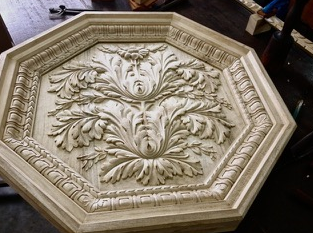Six fears and myths about the woodcarving industry
 After the modernism that followed the war, no one expected we'd see hand-carved ornamentation in our architecture again, writes Master Carver Ian Agrell. Yet here it is. We’re enjoying a resurgence in classical decoration, whether it's a restoration of a 400-year-old church, a brand-new chapel with a Gothic organ case, or a Louis XIV-style library for a billionaire's London penthouse.
After the modernism that followed the war, no one expected we'd see hand-carved ornamentation in our architecture again, writes Master Carver Ian Agrell. Yet here it is. We’re enjoying a resurgence in classical decoration, whether it's a restoration of a 400-year-old church, a brand-new chapel with a Gothic organ case, or a Louis XIV-style library for a billionaire's London penthouse.
Large architectural firms are increasingly winning projects requiring hand-carved woodwork. However, many of these companies—especially those more experienced in modern styles—know little about classical decoration or the ornamentation industry as a whole. They might not know that woodcarving workshops still exist.

Worryingly, they might tell their client that a Gothic organ case can't be done because they themselves don't know it can be done. Or, they might assume that a carving workshop that employs centuries-old tools and techniques is unable meet the modern demands of a large-scale project.
However, there are woodcarving companies and individuals who have the experience to tackle large ornamentation projects. And it's our job, as an industry, to convince these architects that we woodcarvers can do the work efficiently, professionally, and to the highest-possible quality. So, let's start by allaying a few myths—and fears—about our industry by giving an idea of what you can expect from an experienced classical carving firm.
 “No one knows how to carve by hand anymore. Surely they use machines.”
“No one knows how to carve by hand anymore. Surely they use machines.”
Many woodcarvers still use hand tools exclusively—and they don't do it because it's cute. They do it because it's still the most efficient way to create the most beautiful and historically accurate decoration. Finding someone who makes a living as a classical carver can difficult, but they are out there. The City & Guilds of London Art School, where I studied many years ago, continues to teach young people how to carve by hand. In some cases you'll find furniture makers who can do it. But be careful: A woodworker might know how to use mallet and chisel, but without the proper training, he or she won't have sufficient knowledge of the classical styles. It takes years of study to understand the nuances of high-quality carved decoration; some of the best carvers I know worked for at least 7 years before they really felt comfortable communicating these subtleties. If you're looking for woodcarvers who still use hand tools and can produce the highest-caliber work, start by contacting the Master Carvers Association, which is a network of around 40 highly experienced carvers who work in wood, stone, or both.
 “The carver won't have the historical knowledge to fully understand the style.”
“The carver won't have the historical knowledge to fully understand the style.”
He or she may not, unfortunately. And some of these people write books on woodcarving. Before you hire a carver, first spend some time educating yourself. Study exceptional examples of hand-carved decoration, such as Luke Lightfoot's work at Claydon House, and, or course, anything at Versailles. Attend workshops hosted by organisations such as the Royal Institute of British Architects (RIBA) in the UK and Institute of Classical Architecture & Art (ICAA) in the USA. Then take a good look at your carver's previous work. A quality woodcarver should be well versed in all the styles and, at the very least, be able to tell the difference between rococo and French Baroque, or Gothic and Renaissance, or Art Nouveau and Art Deco.
“The carver won't understand our complicated technical drawings.”
Most carvers are not old men holed up in a barn with a gas lamp. Modern architectural carving companies, whether large firms or individuals, are not only adept at understanding an architect's language but also willing to make recommendations on what they see in the drawings. Often an architect’s plans illustrate decoration as little more than a few squiggly lines. It's the carver's job to interpret the design and to offer options that fit the budget. Again, look at the carver's work history to see how much experience he or she has working on large, complicated projects.
“They won't know how to work with others on the project.”
Experienced carving companies operate just like any reputable plumbing or electrical firm: They know how to integrate with the rest of the team and they understand their role on a project. They know how to conduct themselves on a busy job site. They understand the timing of a project and exactly when they'll be needed. Perhaps most importantly, they have experience working directly with joinery companies, mill shops, and carpenters.
“It’s going to cost a lot—far too much for our budget.”
There's no escaping the fact that hand-carved decoration can be expensive. Keep in mind, though, that most carvers charge less per hour than what your local car mechanic does. It's just that carving takes many hours to produce. As mentioned above, we use the same tools and techniques as those employed centuries ago.
But carving doesn't have to be cost prohibitive. The key is figuring out as early as possible what your clients really want—and what they're willing to spend. It's no good getting two years into a project before realising the carving is out of the budget. I've seen this scenario before: The client panics and then settles for poor-quality decoration that fits the budget. But guess what? That bad decoration still cost a lot of money.
Instead, budgeting issues can be solved early in the design stage by reducing the volume of decoration while maintaining its complexity, or by reducing its complexity and maintaining the volume. Notice I never mentioned quality. Never sacrifice quality; you can still have carving that isn't complex but that is still well-executed and true to the design intent.
Finally, put the value of the carving in perspective. Ask yourself, how much is being spent on the plaster work? The painting? The stonework? The entertainment system? Then consider that high-quality carved decoration will be around forever and survive as a historical heirloom.
“They won't have the capacity to manage the workload and won't deliver on time.”
A large project could include a dozen Corinthian capitals that take 200 hours apiece to carve. Luckily, there are companies that have the capacity to produce hundreds of carving hours a week. When getting bids, its an important question to ask; after all, delivery is almost always as important as quality. On large projects with dozens of subcontractors and overlapping timelines, the last thing an architect wants to worry about is whether the carved decoration will be delivered on time. So it's important that the carving company can guarantee a high capacity of carving hours in order to deliver on time. That doesn't necessarily mean you have to find a company with lots of carvers on staff. In many cases, an individual carver might collaborate with other independents in order to handle the workload.
Ian Agrell is a Master Carver and the principal at Agrell Architectural Carving, a woodcarving company with a capacity to produce 50,000 hours of hand-carved decoration annually. Together with his team of highly trained woodcarvers, Agrell has created a world-renowned workshop with a reputation for exceptional craftsmanship.
To find out more about woodcarving visit www.agrellcarving.co.uk














